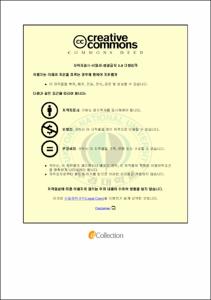자동차 후진기어용 축재의 이종마찰용접에 관한 연구
- Alternative Title
- A Study on the Dissimilar Friction Welding of Reverse Idle Gear Shaft Materials for Automobile
- Abstract
- 자동차 후진 기어용 축에 사용되는 단조품 SF45재와 SM45C재의 이종마찰용접시험을 수행하여 기계적 성질과 경도분포 등을 고찰하여 마찰용접최적화와 비파괴적 품질평가 및 용접후 열처리재의 강도를 평가한 결과 다음과 같은 결론을 얻었다.
1. SM45C와 SF45의 접합재 강도가 모재와 비슷한 이종재 마찰용접 적용이 가능함을 알 수 있었고, 본 연구의 개발로 종전의 단조품에 비해 재료의 기계가공에 따른 공정수 및 재료 절감의 효과가 기대된다.
2. 업셋량과 가열시간과의 사이에는 좋은 양의 상관관계(r=0.99)가 성립함을 알 수 있었다. 따라서 마찰용접과정에서 업셋길이를 조절하여 용접제품의 길이치수 정밀도 등을 요구할 경우에 효율적으로 적용할 수 있음을 알았다. 또한 모든 용접조건에서 용접부의 접합효율이 모재와 비슷한 결과를 보였으나, 용접재의 강도, 연성 및 인성(충격에너지)을 고려한 최적 마찰용접조건은 다음과 같이 결정되었다.
n=2,000(rpm), P₁=70(MPa), P₂=140(MPa), t₁=7(s), t₂=5(s)
3. 모재의 경도는 SM45C이 HV220으로 SF45의 HV160보다 다소 높은 편이며, 이들 재료의 용접계면의 경도는 약 HV265로서 두 재료의 모재보다 아주 높게 나타났다. 또한 후열처리재의 경도값은 약 HV700으로 전체가 비슷한 경향으로 나타났으며, 용접재에 비해서 3배 이상 높게 나타남을 알 수 있다. 이는 용접후열처리에 의한 연성치는 저하된 반면에 강도값의 상승에 따른 결과로 판단된다.
4. 최적조건에서 마찰용접한 용접부의 미세조직을 관찰한 결과는 두 이종재가 강렬히 혼합하여 결정립이 재결정하여 더욱 미세화 되었으며, 용융물이나 입자성장이 없는 미세입자의 혼합조직을 형성하여 아주 양호한 접합상태임을 알 수 있었다.
5. 최적의 마찰용접조건으로 결정된 가열시간 7초인 경우의 AE총 누적량이 약 20300으로 나타났으며, 전반적인 경향은 가열시간이 증가함에 따라 AE총 누적량이 증가함을 알 수 있었다. 마찰 가열시간과 초음파 감쇠계수와의 상관관계는 나타나지 않았으나, 정확한 품질 평가를 위해서는 더 많은 실험 데이터에 의한 고찰이 필요하다고 사료된다.
6. 마찰용접 후열처리재의 강도는 전반적으로 용접재보다 우수한 결과를 보였다. 따라서 실용적인 관점에서 이종마찰용접에 의한 자동차 후진 기어용 제품의 생산이 가능하리라 사료된다.
Friction welding (FRW) is a solid-state welding process that produces a weld under compressive force contact of pieces rotating or moving relative to one another to produce heat and plastically displace material from the faying surfaces. The friction welding has been shown to have significant mic and technical advantages. Recently, according to industrial development, friction welding has been applied on various industries such as aerospace, ship, farm machines, mobile, and machine component fields, etc. However, one of the major concerns in using the friction welding products is the reliability of the weld quality. No reliable nondestructive test evaluation is available at present to check the weld quality, particularly in a production environment.
In this study, an experimental study was conducted not only to optimize the dissimilar friction welding conditions for 20mm diameter solid bar in forging steel (KS SF45) to carbon steel (KS SM45C) of reverse idle gear shaft materials for automobile, but also to investigate the relationship between the weld parameters and the nondestructive coefficients, such as total AE counts and ultrasonic attenuation coefficient. The main friction welding parameters were selected to endure good quality welds on the basis of visual examination, tensile tests, Virkers hardness surveys of the bond of area and HAZ and macrostructure investigations. The specimens were tested as-welded and post weld heat treated (PWHT). And also, the relationships between the weld parameters and the nondestructive coefficients, such as AE total counts and ultrasonic attenuation coefficient.
The study has led to the following concluding remarks. The tensile strength of the friction welded steel bars was increased up to about 100% of the SF45 base metal under the condition of the heating time over 7(s). The total upset increases lineally with increasing the heating time. Optimal welding conditions were determined as follows; rotating speed, n=2,000 (rpm), heating pressure, P₁=70(MPa), upsetting pressure, P₂=140(MPa), heating time, t₁=7(s) and upsetting time, t₂=5(s) when the total upset length is 7.9(mm). Hardness distribution after PWHT shows HV700. All PWHT welded parts shows about 3 time higher hardness than as-welded material. The weld interface of dissimilar friction welded parts was strongly mixed to show a well-combined structure of macro-particles without particle growth or any defects.
- Issued Date
- 2009
- Awarded Date
- 2009. 2
- Type
- Dissertation
- Keyword
- 이종마찰용접
- Publisher
- 부경대학교 산업대학원
- Alternative Author(s)
- Yoon, Seong-Pil
- Affiliation
- 부경대학교 산업대학원
- Department
- 산업대학원 기계공학과
- Advisor
- 김선진
- Table Of Contents
- 1. 서론 = 1
2. 이론적 배경 = 5
2.1 마찰용접의 원리 및 장단점 = 5
2.2 마찰열 발생에 대한 해석 = 10
2.3 AE 신호의 특성 = 13
2.4 초음파 감쇠계수 = 16
3. 시험편 및 실험방법 = 20
3.1 재료 및 시험편 = 20
3.2 실험장치 및 실험방법 = 24
4. 실험결과 및 고찰 = 30
4.1 SM45C-SF45 이종 마찰용접 최적화 = 30
4.1.1 용접조건과의 상관성 = 30
4.1.2 가열시간과 업셋량과의 상관성 = 33
4.1.3 용접변수와 강도의 상관성 = 36
4.1.4 가열시간과 충격에너지와의 상관성 = 41
4.1.5 용접부의 경도 분포 = 44
4.1.6 용접부의 조직 관찰 = 46
4.2 비파괴시험법에 의한 마찰용접 품질 평가 = 48
4.2.1 마찰용접시 AE누적총량과 가열시간과의 관계 = 48
4.2.2 초음파 감쇠계수와 가열시간과의 관계 = 50
4.3 마찰용접 후열처리재의 강도 평가 = 52
4.3.1 후열처리재의 강도 특성 = 52
4.3.2 후열처리재의 경도 분포 = 54
4.3.3 후열처리재의 조직 관찰 = 56
5. 결론 = 58
참고문헌 = 60
감사의 글 = 63
- Degree
- Master
- Files in This Item:
-
-
Download
 자동차 후진기어용 축재의 이종마찰용접에 관한 연구.pdf
기타 데이터 / 1.83 MB / Adobe PDF
자동차 후진기어용 축재의 이종마찰용접에 관한 연구.pdf
기타 데이터 / 1.83 MB / Adobe PDF
-
Items in Repository are protected by copyright, with all rights reserved, unless otherwise indicated.